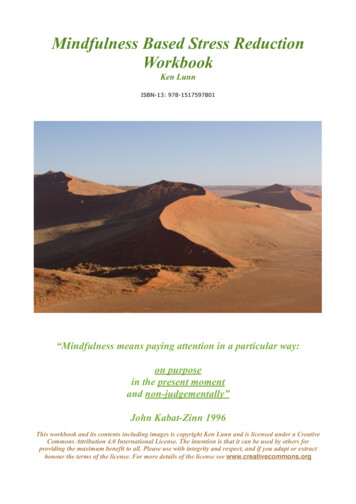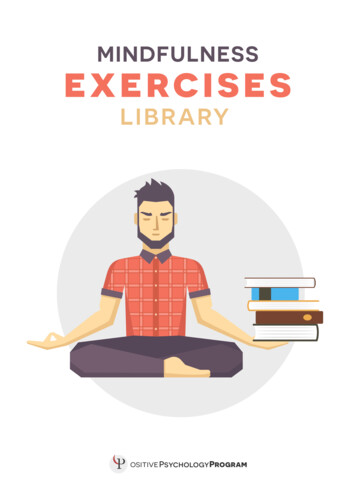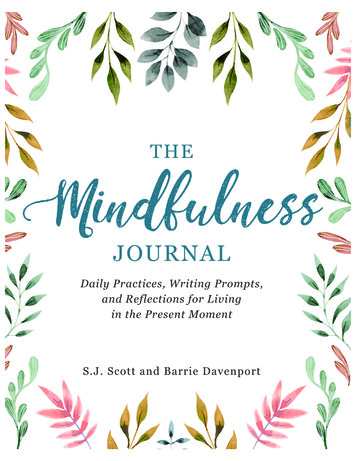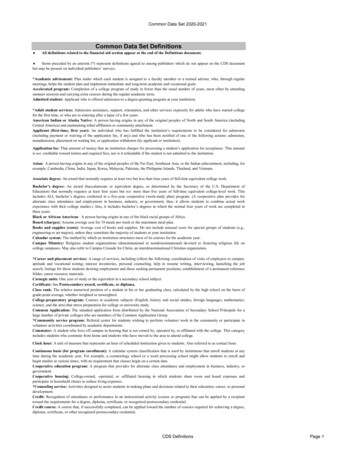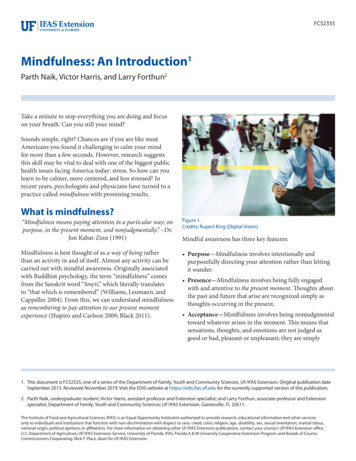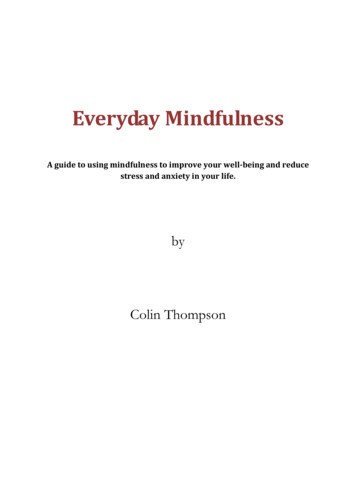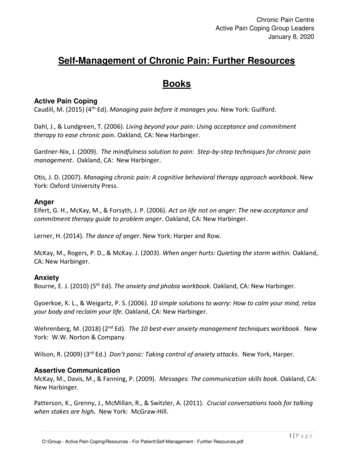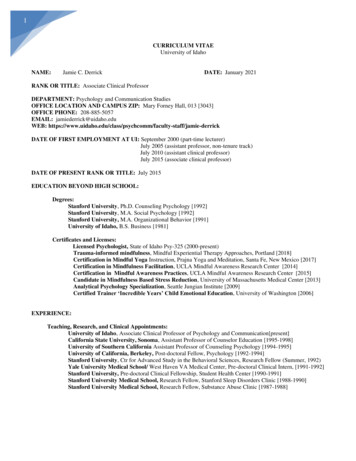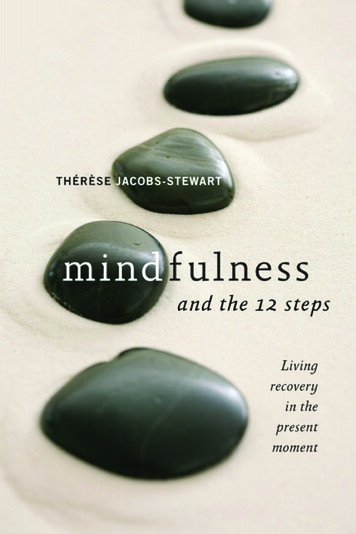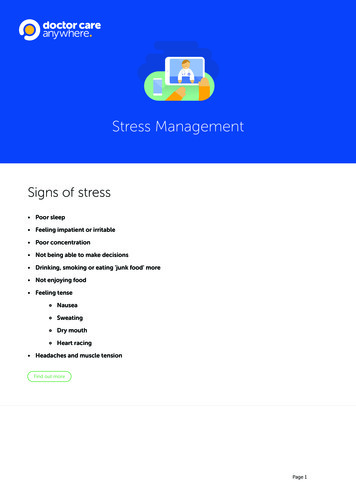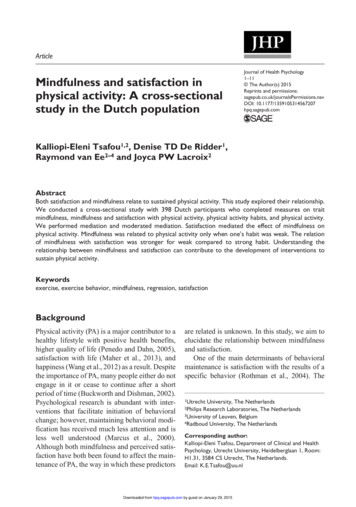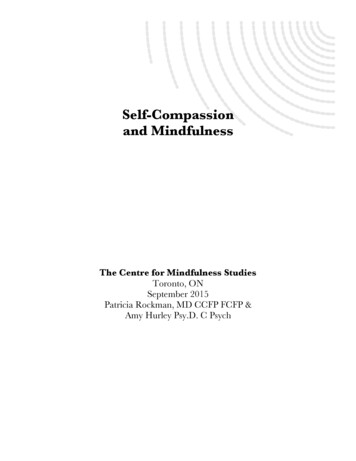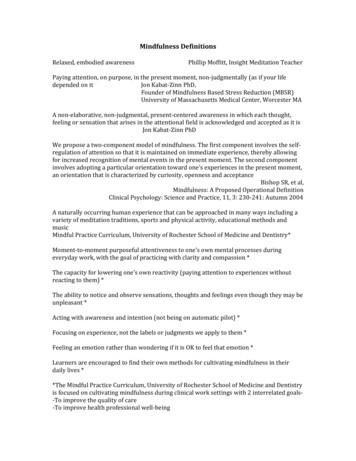
Transcription
Mindfulness DefinitionsRelaxed, embodied awarenessPhillip Moffitt, Insight Meditation TeacherPaying attention, on purpose, in the present moment, non‐judgmentally (as if your lifedepended on itJon Kabat‐Zinn PhD,Founder of Mindfulness Based Stress Reduction (MBSR)University of Massachusetts Medical Center, Worcester MAA non‐elaborative, non‐judgmental, present‐centered awareness in which each thought,feeling or sensation that arises in the attentional field is acknowledged and accepted as it isJon Kabat‐Zinn PhDWe propose a two‐component model of mindfulness. The first component involves the self‐regulation of attention so that it is maintained on immediate experience, thereby allowingfor increased recognition of mental events in the present moment. The second componentinvolves adopting a particular orientation toward one’s experiences in the present moment,an orientation that is characterized by curiosity, openness and acceptanceBishop SR, et al,Mindfulness: A Proposed Operational DefinitionClinical Psychology: Science and Practice, 11, 3: 230‐241: Autumn 2004A naturally occurring human experience that can be approached in many ways including avariety of meditation traditions, sports and physical activity, educational methods andmusicMindful Practice Curriculum, University of Rochester School of Medicine and Dentistry*Moment‐to‐moment purposeful attentiveness to one’s own mental processes duringeveryday work, with the goal of practicing with clarity and compassion *The capacity for lowering one’s own reactivity (paying attention to experiences withoutreacting to them) *The ability to notice and observe sensations, thoughts and feelings even though they may beunpleasant *Acting with awareness and intention (not being on automatic pilot) *Focusing on experience, not the labels or judgments we apply to them *Feeling an emotion rather than wondering if it is OK to feel that emotion *Learners are encouraged to find their own methods for cultivating mindfulness in theirdaily lives **The Mindful Practice Curriculum, University of Rochester School of Medicine and Dentistryis focused on cultivating mindfulness during clinical work settings with 2 interrelated goals‐‐To improve the quality of care‐To improve health professional well‐being
Meditation Maintenance: A Follow on Course Anna Black and Catherine GreyTHE ATTITUDINAL FOUNDATIONS OF MINDFULNESS PRACTICE(Adapted from Full Catastrophe Living by Jon Kabat-Zinn)1. Non-Judging Taking the stance of an impartial witness to your own experience. Noticing the stream of judging mind . good / bad / neutral not trying tostop it but just being aware of it.2. Patience Letting things unfold in their own time A child may try to help a butterfly emerge by breaking open a chrysalis butchances are the butterfly won’t benefit from this help. Practising patience with ourselves. “Why rush through some moments inorder to get to other ‘better’ ones? Each one is your life in that moment.” Being completely open to each moment, accepting its fullness, knowing thatlike the butterfly, things will emerge in their own time.3. Beginner’s Mind Too often we let our thinking and our beliefs about what we ‘know’ stop usfrom seeing things as they really are. Cultivating a mind that is willing to see everything as if for the first time. Being receptive to new possibilities not getting stuck in a rut of our ownexpertise. Each moment is unique and contains unique possibilities. Try it with someone you know – next time, ask yourself if you are seeingthis person with fresh eyes, as he/she really is? Try it with problems withthe sky with the dog with the man in the corner shop.4. Trust Developing a basic trust in yourself and your feelings. Trusting in your own authority and intuition, even if you make some‘mistakes’ along the way. Honour your feelings. Taking responsibility for yourself and your own wellbeing.5. Non-Striving Meditation has no goal other than for you to be yourself. The irony is youalready are. Paying attention to how you are right now – however that it is. Just watch. The best way to achieve your own goals is to back off from striving andinstead start to really focus on carefully seeing and accepting things as theyare, moment by moment. With patience and regular practice, movementtowards your goals will take place by itself.6. Acceptance Seeing things as they actually are in the present. If you have a headache,accept you have a headache.
Meditation Maintenance: A Follow on Course Anna Black and Catherine GreyWe often waste a lot of time and energy denying what is fact. We are tryingto force situations to how we would like them to be. This creates moretension and prevents positive change occurring. Now is the only time we have for anything. You have to accept yourself asyou are before you can really change. Acceptance is not passive; it does not mean you have to like everything andabandon your principles and values. It does not mean you have to beresigned to tolerating things. It does not mean that you should stop trying tobreak free of your own self-destructive habits or give up your desire tochange and grow. Acceptance is a willingness to see things as they are. You are much morelikely to know what to do and have an inner conviction to act when you havea clear picture of what is actually happening.7. Letting Go Letting go is a way of letting things be, of accepting things as they are. We let things go and we just watch If we find it particularly difficult to let go of something because it has such astrong hold on our mind, we can direct our attention to what ‘holding’ feelslike. Holding on is the opposite of letting go. Being willing to look at theways we hold on shows a lot about its opposite. You already know how to let go Every night when we go to sleep we letgo.
26 WAYS:MINDFULNES AND STRESS REDUCTION ON THE GOModified and expanded from Saki Santorelli’s 21 ways to reduce stress during the workday for theMindful Living Program. José Calderón-Abbo, M.D.The following ways are simply a road map. Allow your curiosity and sense of possibilityto unfold as you explore “your own ways”1. Place a reminder to bring awareness to your breath or do a brief meditation from 3to 30 minutes in the morning before your mind embarks on rushing or planningfor the day2. Daily routine: Use common activities to ground yourself. For example, whilewashing dishes, be mindful of the sensations of the water and soap, themovements of your hands when thoughts come, letting them come and lettingthem go, and gently bringing your awareness to the washing of dishes. This samemindfulness can be brought to folding clothes, cleaning, walking, taking ashower, brushing teeth – any activity3. As you enter the car and before you turn on the ignition, take a few deep breaths,and mindfully and kindly inquire- “How am I?”- noticing what is present(thoughts, emotions, body sensations)4. While driving or working, bring awareness to any body tension present, e.g. handswrapped tightly around the steering wheel, shoulders raised, stomach tight. Bringawareness to the breath dissolving the tension with each outbreath5. While driving decide not to play the radio or talk on the cellphone. Sense the carmoving, its speed and the position of your body sitting, the noises andtemperature. How does it feel to drive “mindfully”?6. Red lights and stop signs are natural reminders to stop and just be, bringingawareness to your breath, the sky or the trees, do a mini mindful exercise. (Keepyour eyes open!!)7. On the interstate, experiment with riding in the right lane, going 5 miles below thespeed limit8. Take a moment to orient yourself to your workday once you park your car atwork. Use the walk across the parking lot to step into your life, to know whereyou are, and where you are going instead of what you need to do9. While booting the computer, do a mini mindfulness exercise or bring awarenessto your breath. Notice any tension in the body and let it dissolve. You can domindful stretches at your deskMindful Living Program 2009 Stress Reduction and Wellness: José Calderón-Abbo, M.D.504-891-8808 www.mindfulpsychiatry.com1
10. Use a computer screensaver, or cell-phone wallpaper with words or phrases toremind you to breath, regroup and recoup, i.e. “breathing in I relax” or “breathe”.11. Use breaks to truly relax rather than simple “pausing”. For instance, instead ofhaving coffee or a cigarette or reading or surfing the net, try taking a short walk,or sitting at your desk. Use it to collect yourself focusing on the breath or do amini mindfulness exercise12. At lunch, changing your environment can be helpful13. Try closing the door, take your shoes off and take time to consciously relax14. Decide to “STOP” for 1-3 minutes every couple of hours during the workday.Become aware of how you are breathing and of your bodily sensations, allowingthe mind to settle-in as time to regroup and recoup.15. Use everyday cues in your environment as reminders to “center” yourself, e.g.when the telephone rings, sitting at the computer desk, parking the car beforegetting out. Use the sky, trees, a song or a poem posted on your wall to remindyou of the bigger picture.16. Chose to eat one or two lunches per week in silence and mindfully. Use this timeto eat slowly and be with yourself.17. At the end of the workday, try retracing today’s activities acknowledging andcongratulating yourself for what you’ve accomplished and then make a list fortomorrow. You’ve done enough for the day!18. Pay attention to the short walk to your car –breathing in the warm or cold freshair. Feel the cold or warmth in your body. What may happen if you open to andaccept these environmental conditions and bodily sensations rather than resistingthem? Listen to the sounds outside your workplace. Can you walk without feelingrushed? What happens when you slow down?19. At the end of the workday when your car is warming up, sit quietly andconsciously make the transition from work to home, taking a moment to simplybe, enjoying it for a moment! Like most of us, you are heading to your next fulltime job –home!20. When you pull into the driveway or park on the street, take a minute to orientyourself to being with your family members, or pets21. Try changing your work clothes when you get home. Wash you hands and face.Brush your teeth. This simple act might help you to make a smoother transitioninto your next “role”; much of the time you can probably spare 5-minutes to dothis. Say hello to each family member, pets or to the people you live with. Take aMindful Living Program 2009 Stress Reduction and Wellness: José Calderón-Abbo, M.D.504-891-8808 www.mindfulpsychiatry.com2
moment to look into their eyes. If you live alone, feel what it feels like to enter thequietness of your home and the feeling of entering your own environment22. Try using bathroom routines to regroup and recoup. For example, try not to reador text when in the bathroom, rather tune yourself to the sensations of the body.When brushing teeth or showering, use your non-dominant hand or change yourcleaning routine. These changes will help you stay present23. If possible, at the end of the day and before you go to bed, take 5-10 minutes to bequiet and still, do a mini-meditation or just follow the breath24. Wear a piece of clothing, a tag, a bracelet or a pin to remind you during the day tobreath and to treasure that moment of your life, the only life you have25. Use natural times to wait as opportunities to take a few breaths, and check-in withyourself. This can occur while waiting or riding an elevator, while waiting in lineat the grocery store, or while waiting for someone else26. Limit texting, answering mail, phone calls, following Twitter or Facebook tospecific times in the day, for example, two to four times during the day atscheduled times, and no less than 60-minutes before you go to bed27. Write your ownMindful Living Program 2009 Stress Reduction and Wellness: José Calderón-Abbo, M.D.504-891-8808 www.mindfulpsychiatry.com3
Present Moment, Wonderful Moment‐Mindfulness Verses for Daily LivingThich Nhat Hanh, Vietnamese Buddhist Monk and Zen MasterReciting familiar phrases (traditionally called gathas) during daily activities can help cultivatemindfulness anywhere, anytime. Practitioners are encouraged to develop their own verses to suit theirpersonal preferences and particular activities.Waking upWaking up this morning, I smile.Twenty‐four brand new hours are before me.I vow to live fully in each momentand to look at all beings with eyes of compassion.Turning on the light/Lighting the candleForgetfulness is the darkness,Mindfulness is the light.I bring awareness to shine upon all life.Taking the first steps of the dayWalking on the Earth is a miracle.Each mindful step reveals the wonders of all creation.Opening the windowOpening the window, I look out on the natural world.How wondrous is life!Attentive to each moment,My mind is clear like a calm river.Turning on the waterWater flows from high in the mountains.Water runs deep in the Earth.Miraculously, water comes to us, and sustains all life.Washing your handsWater flows over these hands.May I use them skillfully to preserve our precious planet.Brushing your teethBrushing my teeth and rinsing my mouth,I vow to speak purely and lovingly.When my mouth is fragrant with right speech,A flower blooms in the garden of my heart.
BathingRinsing my body, my heart is cleansed,The universe is perfumed with flowers.Actions of body, speech and mind are calmed.Getting dressedPutting on these clothes, I am grateful to those who made themAnd to the materials from which they were made.I wish everyone could have enough to wear.Serving foodIn this food, I see clearly the presence of the entire universe supporting my existence.Using the telephoneWords can travel thousands of miles.May my words create mutual understanding and love.May they be as beautiful as gems, as lovely as flowers.BreathingBreathing in, I calm my body.Breathing out, I smile.Dwelling in the present moment,I know this is a wonderful moment.Ending the dayThe day is ending, our life is one day shorter. Let us look carefully at what we have done.Let us practice diligently, putting our whole heart into the practice of meditation.Let us live deeply each moment in freedom, so time does not slip away meaninglessly.Present Moment, Wonderful Moment (Mindfulness Verses for Daily Living) by Thich Nhat Hanhis available from Parallax Press, which is the publisher for TNH’s daily‐living‐rev‐ed/
5 Progressive Mindfulness ExercisesFrom Full Catastrophe Living by Jon Kabat‐ZinnExercise 1Sitting with the Breath‐Practice awareness of your breathing (just feeling the physical sensation of the breathing) in acomfortable but erect posture for at least 10 minutes at least once a day‐Each time you notice that your mind is no longer on your breath, just see where it is. Then let go andcome back to your belly and to your breathing‐Over time try extending the time you sit until you can do it for 30 minutes or more. But remember,when you are really in the present, there is no time, so clock time is not as important as yourwillingness to pay attention and let go from moment to momentExercise 2Sitting with the Breath and the Body as a Whole‐When your practice feels strong in the sense that you can maintain some continuity of attention onthe breath, try expanding the field of your awareness ‘around’ your breathing and ‘around’ your bellyto include a sense of your body as a whole as you are sitting‐Maintain this awareness of the body sitting and breathing, and when the mind wanders, bring itback to sitting and breathingExercise 3Sitting with Sound‐If you feel like it, try just listening to sound when you meditate. This does not mean listening forsounds, rather just hearing what is here to be heard, moment by moment, without judging orthinking about it. Just hearing sounds as pure sound. And hearing the silences in and between soundsas well.‐ You can practice this with music, too, hearing each note as it comes and the spaces between notes.Try breathing the sounds into your body and letting them flow out again on the outbreath. Imagineyour body is transparent to sounds; that they can move in and out of your body through the pores ofyour skinExercise 4Sitting with Thoughts and Feelings‐When your attention is relatively stable on the breath, try shifting your awareness to the process ofthinking itself. Let go of the breath and just watch thoughts come into and leave the field of yourattention‐Try to perceive them as ‘events’ in your mind‐Note their content and their charge while, if possible, not being drawn into thinking about them, orthinking the next thought, but just maintaining the ‘frame’ through which you are observing theprocess of thought‐Note that an individual thought does not last long. It is impermanent. If it comes, it will go. Be awareof this.‐Note how some thoughts keep coming back.‐Note those thoughts that are ‘I’, ‘me’ or ‘mine’ thoughts, observing carefully how ‘you’, the non‐judging observer, feel about them‐Note when the mind creates a ‘self’ to be preoccupied with how well or how badly your life is going‐Note thoughts about the past and thoughts about the future‐Note thoughts that are about greed, wanting, grasping, clinging‐Note thoughts that are about anger, disliking, hatred, aversion, rejection‐Note feelings and moods as they come and go‐Note what feelings are associated with different thought contents‐If you get lost in all this, just go back to your breathingThis exercise requires great concentration and should only be done for short periods of time, like 2‐3minutes in the early stagesExercise 5Sitting with Choiceless Awareness‐Just sit. Don’t hold on to anything. Don’t look for anything. Practice being completely open andreceptive to whatever comes into the field of awareness, letting it all come and go, watching,witnessing in stillness
20 Scientific Reasons to Start Meditating Today Psychology Today9/18/13 1:36 PMMentally simulating the future can help reduce ourimpulsive urge to give in to feel good now.Timothy A. Pychyl, Ph.D.HomeFind a TherapistTopic StreamsGet HelpMagazineTestsPsych BasicsFeeling ItEmotional expertise for happiness and successby Emma M. Seppala, Ph.D.20 Scientific Reasons to Start Meditating TodayExpertsEmma Seppala, Ph.D, is AssociateDirector of the Center forCompassion and Altruism Researchand Education at StanfordUniversity.more.New research shows meditation boosts your health, happiness, and success!Published on September 11, 2013 by Emma M. Seppala, Ph.D. in Feeling ItSubscribe to Feeling It4.9kStumbleUpon316SubmitLikeTweet7157Subscribe via RSSShareI started meditating soon after 9/11. I was living in Manhattan, an already chaotic place, at an extremelychaotic time. I realized I had no control over my external environment. But the one place I did have asay over was my mind, through meditation. When I started meditating, I did not realize it would alsomake me healthier, happier, and more successful. Having witnessed the benefits, I devoted my PhDresearch at Stanford to studying the impact of meditation. I saw people from diverse backgrounds fromcollege students to combat veterans benefit. In the last 10 years, hundreds of studies have beenreleased. Here are 20 scientifically-validated reasons you might want to get on the bandwagon today:It Boosts Your HEALTH1 - Increases immune function (See here and here)Related ArticlesHope is Associatedwith a StrongerImmune System inHIV IndividualsThe Roots of PowerStruggle inRelationshipsPTSD is a chronicimpairment of the bodysense: Why we needembodied approachesto treat traumaThe Body's BottledMessagesSmile Away the FluFind a TherapistSearch for a mentalhealth professionalnear you.City or Zip2 - Decreases Pain (see here)3 - Decreases Inflammation at the Cellular Level(See here and here and here)It Boosts Your HAPPINESS4 - Increases Positive Emotion (here and here)5 - Decreases Depression (see here)Feeling ItRecent PostsNew research shows meditationboosts your health, happiness,and success!Desire brings us joy. Learn toharness its benefits while avoiding itsdangers.6 - Decreases Anxiety (see here and here and here)7 - Decreases Stress (see here and here)It Boosts Your SOCIAL LIFEThink meditation is a solitary activity? It may be (unless you meditate in agroup which many do!) but it actually increases your sense of connectionto others:8 - Increases social connection & emotional intelligence (see here and - byyours truly - here)9 - Makes you more compassionate (see here and here and here)Some quick ways to make adifference from your desk and feelgreat doing soHow sharing your good newsincreases well-beingSome people argue that women arekinder, but what does the data reallyshow?More of Feeling It blogMost -it/201309/20-scientifi start-meditating-today?goback %2Egde 3703348 member 274174248#%21Page 1 of 4
20 Scientific Reasons to Start Meditating Today Psychology Today10 - Makes you feel less lonely (see here)It Boosts Your Self-Control11 - Improves your ability to regulate your emotions (see here) (Ever flownoff the handle or not been able to quiet your mind? Here's the key)Find Local:AcupuncturistsChiropractorsMassage TherapistsDentistsand more!City or Zip12 - Improves your ability to introspect (see here & for why this is crucialsee this post)9/18/13 1:36 PMMost ReadMost Emailed1What Your Selfies Say About You2The Rare Truth About "Tight" and"Loose" Womenby Peggy Drexler, Ph.D.by Michael Castleman, M.A.3The Paradox of Seductionby Leon F. Seltzer, Ph.D.It Changes Your BRAIN (for the better)13 - Increases grey matter (see here)14 - Increases volume in areas related to emotion regulation, positiveemotions & self-control (see here and here)45The Right Weight to Be Attractiveby Fredric Neuman, M.D.Quit: Do It Nowby Heidi Grant Halvorson, Ph.D.15 - Increases cortical thickness in areas related to paying attention(see here)It Improves Your Productivity (yup, by doing nothing)Trauma & the Avoidant ClientRobert T. Muller, Ph.D.16 - Increases your focus & attention(see here and here and here and here)Effectively engage traumatizedclients who avoid attachment,closeness, & painful feelings.Read more17 - Improves your ability to multitask (see here and here)18 - Improves your memory (see here)19 - Improves your ability to be creative & think outside the box (seeresearch by J. Schooler)CalmAidFeel relaxed with CalmAid , clinicallyproven orally administered lavenderoil that helps you stay productive.Read more20. It Makes You WISE(R)It gives you perspective: By observing your mind, you realize you don'thave to be slave to it. You realize it throws tantrums, gets grumpy, jealous,happy and sad but that it doesn't have to run you. Meditation is quitesimply mental hygiene: clear out the junk, tune your talents, and get intouch with yourself. Think about it, you shower every day and clean yourbody, but have you ever showered your mind? As a consequence, you'llfeel more clear and see thing with greater perspective. "The quality of ourlife depends on the quality of our mind," writes Sri Sri Ravi Shankar. Wecan't control what happens on the outside but we do have a say over thequality of our mind. No matter what's going on, if your mind is ok,everything is ok. Right now.It Keeps You RealOnce you get to know your mind, you start to own your stuff and becomemore authentic, maybe even humble. You realize the stories and soapoperas your mind puts you through and you gain some perspective onthem. You realize most of us are caught up in a mind-drama and becomemore compassionate towards others.Anxiety FreeA comprehensive formula with herbsand nutrients clinically proven toincrease feelings of well-being.Read moreCurrent IssueWhen Virtue Becomes ViceThe nature of a virtue is that a vice isalmost always hidden inside.MORE FROM THIS ISSUEISSUE ARCHIVESSUBSCRIBEMyths about MeditationHaving an empty mind—nope, in fact, when you start meditating, you'll findits quite the oppositeSitting in lotus position—nope, you can sit on the couch (just don't liedown, you'll fall asleep)Sitting for an hour a day—nope, small doses work just fine, (see here and by yours truly - t/201309/20-scientifi start-meditating-today?goback %2Egde 3703348 member 274174248#%21Page 2 of 4
20 Scientific Reasons to Start Meditating Today Psychology Today9/18/13 1:36 PMChanting in a language I don't understand—nope, not unless that floatsyour boatBuddhist, Hindu or religious—nope, not unless you make it soWeird—what's so weird about sitting and breathing? Besides, UScongressmen, NFL football leagues and the US Marine Corps are doing it,how weird can it be?Wearing robes—what?"I can't meditate" becauseI can't clear my mind—no worries, while you're sitting there you'llexperience the noisy chaos of a wound up mind that's unwinding: tons ofthoughts, feelings and emotions. Don't worry about how you feel during,notice how you feel after and throughout the rest of the dayI can't sit still—that's ok, just sit comfortably, fidget if you need toI get anxious—that's also normal, all the junk's coming up, learn somebreathing practices to calm yourself down, exercise or do yoga beforemeditatingI hate sitting still—that's fine, then go for a walk without your earphones,phone etc; or start with yoga; or do breathing exercises give yourself timeto just "be" without constantly "doing" somethingI tried and I hated it—there's not just one kind of meditation, there's awhole menu out there, look for the shoe that fits: mindfulness,Transcendental, compassion, mantra, Vipassana, Art of Living breathingpractices, yoga nidra, yoga, insight, loving-kindness, tai chi etc.I don't have time - if you have time to read an article about meditation allthe way through, you have time to meditate. Think of all those minutes youwaste every day on the internet or otherwise, you can definitely fit in 20minutes here or there to give your life a boost! Gandhi is quoted as saying"I'm so busy today, that. I'm going to meditate 2 hours instead of 1."-----To stay updated on the science of happiness, health and socialconnection, see www.emmaseppala.com. Watch Emma's TEDx talk on theScience of Social Connection, Compassion & HappinessFollow Emma on TwitterSubscribe to Emma on FacebookCircle Emma on Google 2013 Emma Seppala, Ph.D.Subscribe to Psychology Today now and get a free issue!16 Reader comments join the discussion here!Follow Psychology m/blog/feeling-it/201309/20-scientifi start-meditating-today?goback %2Egde 3703348 member 274174248#%21Page 3 of 4
Recommended Mindfulness‐Related ResourcesInterviews / VideosOprah interviews Jon Kabat‐ZInn, founder of MBSR (mindfulness‐ based stressreduction) (41:46)Super Soul Sunday April 13, nn‐VideoCBS’ 60 MinutesDecember 14, 2014Anderson Cooper investigatingThis is the full hour‐long showThe Mindfulness segment starts at the 30 minute 30 second markhttps://www.youtube.com/watch?v G‐utzHpIeQgDan Harris10% Happier‐ Mindfulness Applications at WorkABC News Anchor, at Wisdom 2.0 Business Nov 13, 2014YouTube 33:27https://www.youtube.com/watch?v EBcWY2866So6 minute video ‘You are only alive in this moment’From Jon Kabat‐Zinn, the founder Center for Mindfulness in Medicine, Healthcareand Society at U Mass Medical Centerand MBSR (mindfulness‐based stress reduction) Jon Kabat‐Zinnhttp://www.youtube.com/watch?v Cy4ds0Q1RO4&feature relatedMindfulness based stress reduction (MBSR)Jon Kabat‐Zinn‐ Full catastrophe iving‐Revised‐Illness/dp/0345536932/ref sr 1 1?s books&ie UTF8&qid 1396207527&sr 1‐1&keywords full catastrophe livingJon Kabat‐Zinn‐ Wherever you go, there you Are‐ROUGH/dp/1401307787/ref sr 1 1?s books&ie UTF8&qid 1396207592&sr 1‐1&keywords wherever you goJon Kabat‐Zinn‐ Meditation for 076585/ref sr 1 1?s books&ie UTF8&qid 1396207666&sr 1‐1&keywords jon kabat zinn meditation for beginners
Stahl, Meleo‐Meyer, Koerbel‐ A mindfulness based stress reduction workbook 8829731Mindfulness resources other than MBSRJan Chozen Bays MD‐ Mindful eating‐ A guide to rediscovering a healthy and joyfulrelationship wit food (includes CD)Sharon Salzberg‐The Force of Kindness‐ Change your life with love and dness‐Change‐Compassion/dp/1591799201Ruth Baer‐ The practicing happiness arry Boyce‐ The mindfulness p/1590308891/ref sr 1 1?s books&ie UTF8&qid 1396208605&sr 1‐1&keywords mindfulness revolutionJack Kornfield‐ Meditation for ers‐Jack‐Kornfield/dp/1591799422/ref sr 1 1?s books&ie UTF8&qid 1396208739&sr 1‐1&keywords kornfield meditation for beginnersJack Kornfield‐ The art of forgiveness, loving kindness and ingkindness‐Peace/dp/0553381199/ref sr 1 1?s books&ie UTF8&qid 1396208806&sr 1‐1&keywords kornfield the art of forgivenessPema Chodron‐ How to �Practical‐Making‐Friends/dp/1604079339/ref sr 1 1?s books&ie UTF8&qid 1396209634&sr 1‐1&keywords pema how to meditateCD hodron‐Practical/dp/1
(Adapted from Full Catastrophe Living by Jon Kabat-Zinn) 1. Non-Judging Taking the stance of an impartial witness to your own experience. Noticing the stream of judging mind . good / bad / neutral not tryi
